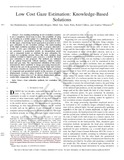Mostrar el registro sencillo del ítem
Low cost gaze estimation: knowledge-based solutions
| dc.creator | Martinikorena Aranburu, Ion | es_ES |
| dc.creator | Larumbe Bergera, Andoni | es_ES |
| dc.creator | Ariz Galilea, Mikel | es_ES |
| dc.creator | Porta Cuéllar, Sonia | es_ES |
| dc.creator | Cabeza Laguna, Rafael | es_ES |
| dc.creator | Villanueva Larre, Arantxa | es_ES |
| dc.date.accessioned | 2020-02-05T09:41:25Z | |
| dc.date.available | 2020-10-18T23:00:11Z | |
| dc.date.issued | 2020 | |
| dc.identifier.citation | I. Martinikorena, A. Larumbe-Bergera, M. Ariz, S. Porta, R. Cabeza and A. Villanueva, 'Low Cost Gaze Estimation: Knowledge-Based Solutions,' in IEEE Transactions on Image Processing, vol. 29, pp. 2328-2343, 2020. doi: 10.1109/TIP.2019.2946452 | en |
| dc.identifier.issn | 1941-0042 | |
| dc.identifier.uri | https://hdl.handle.net/2454/36191 | |
| dc.description.abstract | Eye tracking technology in low resolution scenarios is not a completely solved issue to date. The possibility of using eye tracking in a mobile gadget is a challenging objective that would permit to spread this technology to non-explored fields. In this paper, a knowledge based approach is presented to solve gaze estimation in low resolution settings. The understanding of the high resolution paradigm permits to propose alternative models to solve gaze estimation. In this manner, three models are presented: a geometrical model, an interpolation model and a compound model, as solutions for gaze estimation for remote low resolution systems. Since this work considers head position essential to improve gaze accuracy, a method for head pose estimation is also proposed. The methods are validated in an optimal framework, I2Head database, which combines head and gaze data. The experimental validation of the models demonstrates their sensitivity to image processing inaccuracies, critical in the case of the geometrical model. Static and extreme movement scenarios are analyzed showing the higher robustness of compound and geometrical models in the presence of user’s displacement. Accuracy values of about 3◦ have been obtained, increasing to values close to 5◦ in extreme displacement settings, results fully comparable with the state-of-the-art. | en |
| dc.description.sponsorship | This work was supported in part by the Ministry of Economy and Competitiveness under Grant TIN2014-52897-R and in part by the Ministry of Science, Innovation and Universities under Grant TIN2017-84388-R. | en |
| dc.format.extent | 16 p. | |
| dc.format.mimetype | application/pdf | en |
| dc.language.iso | eng | en |
| dc.publisher | IEEE | en |
| dc.relation.ispartof | IEEE Transactions on Image Processing, vol. 29, 2020 | en |
| dc.rights | © 2020 IEEE. Personal use of this material is permitted. Permission from IEEE must be obtained for all other uses, in any current or future media, including reprinting/republishing this material for advertising or promotional purposes, creating new collective works, for resale or redistribution to servers or lists, or reuse of any copyrighted component of this work in other work. | en |
| dc.subject | Gaze estimation methods | en |
| dc.subject | Low resolution | en |
| dc.subject | Eye tracking | en |
| dc.title | Low cost gaze estimation: knowledge-based solutions | en |
| dc.type | info:eu-repo/semantics/article | en |
| dc.type | Artículo / Artikulua | es |
| dc.contributor.department | Ingeniería Eléctrica, Electrónica y de Comunicación | es_ES |
| dc.contributor.department | Ingeniaritza Elektrikoa, Elektronikoa eta Telekomunikazio Ingeniaritza | eu |
| dc.rights.accessRights | info:eu-repo/semantics/openAccess | en |
| dc.rights.accessRights | Acceso abierto / Sarbide irekia | es |
| dc.embargo.terms | 2020-10-18 | |
| dc.identifier.doi | 10.1109/TIP.2019.2946452 | |
| dc.relation.projectID | info:eu-repo/grantAgreement/MINECO//TIN2014-52897-R/ES/ | en |
| dc.relation.projectID | info:eu-repo/grantAgreement/AEI/Plan Estatal de Investigación Científica y Técnica y de Innovación 2013-2016/TIN2017-84388-R/ES/ | en |
| dc.relation.publisherversion | https://doi.org/10.1109/TIP.2019.2946452 | |
| dc.type.version | info:eu-repo/semantics/acceptedVersion | en |
| dc.type.version | Versión aceptada / Onetsi den bertsioa | es |


